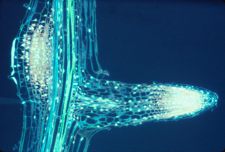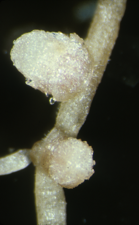
Symbioses
Symbiotic plant-microbe interaction
Symbiotic nitrogen fixation is profoundly important for the environment and sustainable agriculture. Most crop plants assimilate nitrogen only from soil via added fertilizers. An alternative source is the rhizobia-legume symbiosis that provides a major source of fixed nitrogen. Rhizobia are capable of inducing the formation of nodules on the roots of their leguminous host plants. These specialized plant organs are invaded by the bacteria which fix nitrogen in an endosymbiotic bacteroid state within the plant cell. This process involves specific recognition and coordinated differentiation of both bacterial and host cells.

Establishment of
the Sinorhizobium meliloti-Medicago sativa
symbiosis (Figure: D. Kapp, Bielefeld University)
Images of the Sinorhizobium meliloti-Medicago sativa symbiosis (Stanford University, Long lab)






Publisher's details
Responsible Person:Prof. Dr. Anke Becker
Please contact us by e-mail to
Anke.Becker![]() biologie.uni-freiburg.de if there
are mistakes, errors or questions. Any error report is welcome!
Check again in the near future for added functionality and updated
information.
biologie.uni-freiburg.de if there
are mistakes, errors or questions. Any error report is welcome!
Check again in the near future for added functionality and updated
information.
External link disclaimer.
Some links provided on these pages will lead you to external web pages (in a new window of your browser) that we did not implement. We do not have any influence on the contents of these web pages, they are provided for your information only. Although carefully checked, we are not responsible in any way for contents or layout of these pages. We are also not responsible for electronic messages that you may receive from the owners of these web pages.
University of Freiburg
Department of Biology
Prof. Dr. Anke Becker
79104 Freiburg
Germany

